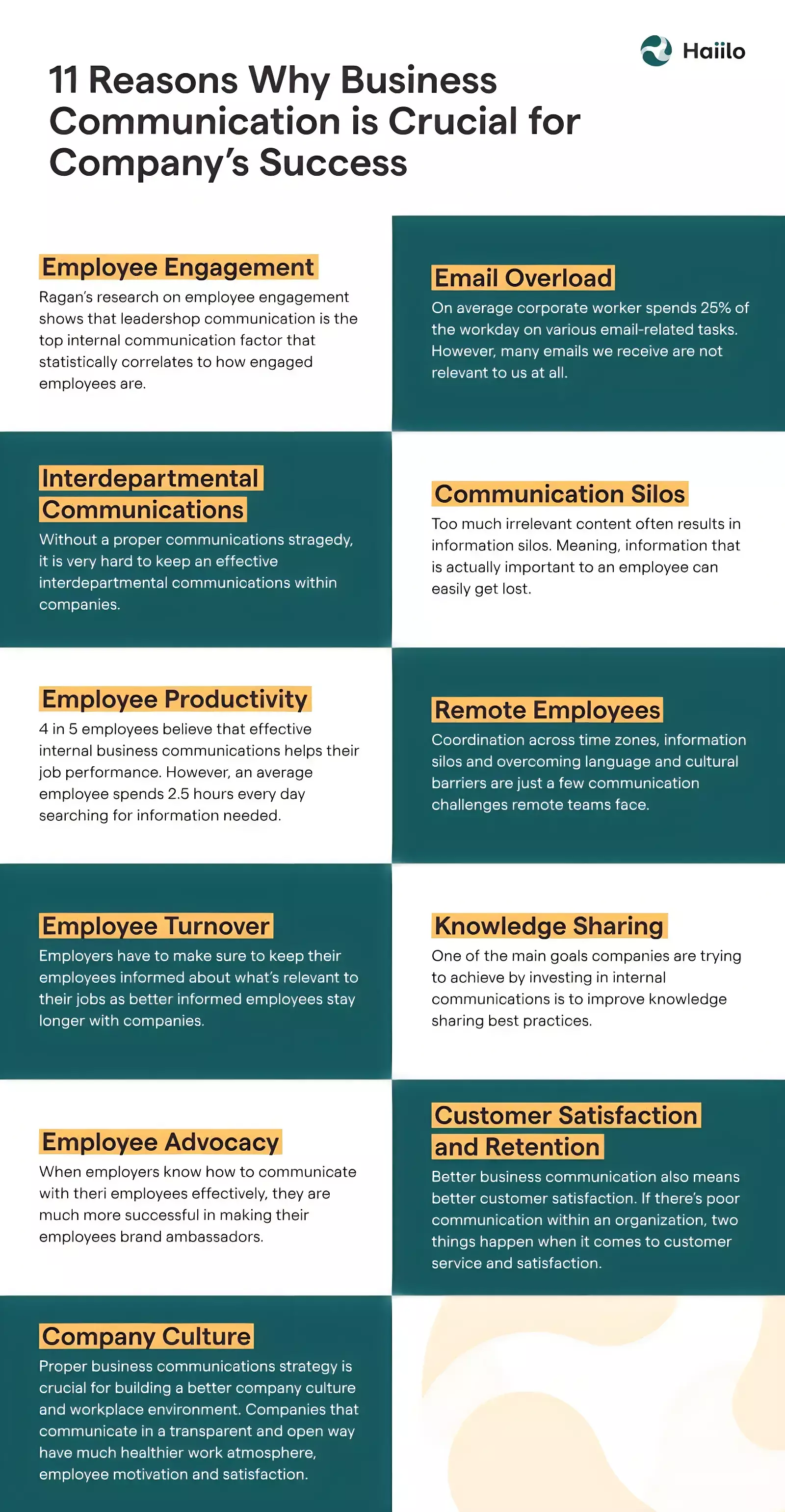What do we mean by internal communication methodology? How do we define it, and what are the benefits of proper communication methods in the workplace?
If these topics are of your interest, keep reading! In this blog, we will talk all about internal communications (IC). You will learn about why internal comms is so important today and how to better leverage it to drive business success and continuity even in unprecedented times.
What Do We Mean by Internal Communication Methodology?
If you browse the internet, you won’t really find an official definition of internal communication methodology. This is surprising as internal communications play a crucial role in driving business success.
Moreover, internal communications professionals are today considered important strategic business partners. Yet, 60% of companies don’t have a long-term strategy for their internal communications.

So if marketing and sales methodologies have their formal definitions, then internal communications (IC) should as well. What’s more, it’s quite similar to marketing. Marketing methodology is all about the process of attracting, converting, and delighting customers using various tactics, marketing methods, and channels.
Similarly, internal communications methodology is all about producing and distributing the right content, capturing the audience’s attention, engaging them with the content, and driving better business results through higher employee engagement and performance.
💡 Related: 5 Ways Effective Internal Communication Can Boost Employee Productivity
What Are the Most Common Internal Communication Methods
The way organizations define their internal communications methodologies highly depends on the communications methods and channels used in the company.
With the emergence of remote and hybrid work, many new communication methods have been introduced, and face-to-face communication is not the primary mean of communication in the workplace anymore.
So let’s take a look at some of the most popular ways employees communicate and collaborate in the workplace.

1. Social intranets
Modern social intranets serve as a digital home or a content hub from which employees can easily access all the important information about the company. Because information overload is one of the biggest productivity killers in the workplace, social intranets have been growing in their popularity.
Furthermore, advanced solutions are designed to support remote and hybrid working environments by enabling distributed workforce to stay connected even when they are physically separated.
💡 Related: 5 Employee Communication Predictions for 2022
2. Employee engagement/experience platforms
Employee engagement apps (a.k.a employee experience platforms) can also be considered a method for employee communications. Most of these tools have a lot of features and functionalities via which employees can connect, collaborate, provide and collect feedback via surveys, recognize their colleagues, evaluate each other, or simply chat with their peers.
📚 If you are looking to learn more about employee engagement apps, check out our buyer’s guide: What Is an Employee Engagement App and Why Your Company Needs One
3. Instant messaging platforms
Instant messaging platforms are probably the most popular internal communication method in the workplace nowadays. Today, there is no organization that doesn’t have an instant messaging solution. Some of the most popular industry players include Slack, Microsoft Teams, and Skype for Business.
4. Video conferencing tools
Video conferencing has become an inevitable part of every business communication methodology, especially in digital workplaces.
Even though some instant messaging solutions have built-in video conferencing, there are players in the market that have captured a big market share. Some of the most popular examples include Zoom, Google Hangouts, GoToMeeting, and similar.
5. Internal newsletter
Internal employee newsletter is another way to communicate in the workplace. However, it should never be the only method to distribute information to employees. Because newsletters usually go one way, this is not the best communication method when employees are expected to engage and share their own thoughts and opinions.
6. Collaboration, productivity, and project management solutions
Project management apps such as Trello, CluckUp, Jira, or Monday.com are also means of communication in the workplace. Even though employees may not use it to chat with each other, they do use it to transfer important information, track the progress of their projects, and improve team communication and collaboration.
These tools help workers stay connected and, therefore, improve productivity. According to research, employee productivity increases by 20 to 25% in organizations where employees are connected.
7. Other internal communications methods
Identifying various internal communication methods in the workplace is quite challenging. In fact, almost any digital tool we use in our organizations can be served to transfer some type of information.
Email is the obvious one! However, many companies today have started using email exclusively for external communication. Email inboxes too often get overcrowded with irrelevant information.

Document sharing tools such as Google Docs or Microsoft Word can also be used as a communication channel.
CRM software is sometimes considered the most important collaboration and communication channel for people in sales and marketing.
In some companies, even social media networks and private messaging apps are used for internal comms.
The Importance of Building a Good Internal Communication Methodology
Your company’s internal communication strategy can make or break your organizational culture. It has a direct impact on your employees’ motivation, engagement, and productivity at work.
So let’s take a look at the 4 biggest reasons why every employer should invest more time and resources into building a proper internal communications plan.
1. Achieve organizational alignment
The biggest reason why organizational communication is so important is because of organizational alignment. When employees are aligned with the company’s mission, vision, and core company values, they are more likely to contribute to business success.
Yet, research shows that 95% of employees do not fully understand the company’s goals or what is expected from them to achieve these goals. And only 23% of executives say that their companies are excellent at aligning employees’ goals with corporate purposes

This is absolutely alarming!
So when defining your organization’s internal communications methodology, make sure that you understand its impact on the overall organizational alignment.
2. Encourage and drive collaboration
Proper internal communication methodology is important for workplace collaboration; both team collaboration and cross-functional collaboration. According to research, 86% of employees and executives cite lack of collaboration or ineffective communication for workplace failures.
This is particularly true for remote workplaces where employees now spend about 50% more time engaged in collaborative work. They depend on various communication methods to collaborate with their colleagues and work on projects together.
3. Improve experience and employee morale
Informed employees who feel connected with their colleagues are more likely to have a positive working experience. Hence, a successful internal communications methodology directly impacts employee experience, happiness, and the overall level of job satisfaction and employee motivation.
Furthermore, according to research, 33% of employees said a lack of open, honest communication has the most negative impact on employee morale.
4. Boost engagement and productivity
All the above-mentioned reasons to invest in internal communications ultimately lead to better employee and business performance.
When teams communicate efficiently, they are able to better understand each other and are more efficient in achieving common goals. As a result, extremely connected teams demonstrate a 21% increase in profitability.
Another research showed that 97% of workers and employers believe that the lack of team alignment influences the success of a task or project.
Looking for more reasons why internal communications is important? Take a look at our infographic!

How to Ensure Proper Internal Communication Methodology in Your Organization
When creating your organization’s internal communication methodology (that’s the process of creating quality content, catching readers’ attention, engaging them with the content, and driving better business results) it is important to follow some best practices.
Let’s take a look at them.
1. Understand your audience
The only way to cut through the noise and catch your audience’s attention is to understand your target group. This is particularly important for companies with a multigenerational workforce.
More and more, employers like to create employee personas – employee profiles based on their age, culture, interests, departments, motivational factors, job nature, and other characteristics.
Understanding these employee characteristics is the first step towards creating an internal communications methodology that works!
2. Make content personalized
One of the biggest reasons why people ignore information or miss it is because a lot of information we receive is irrelevant to us. This is no different within organizations.
According to research, 74% of employees have the feeling they are missing out on company news, and many of them are.
It doesn’t take many generic internal newsletters for employees to start ignoring it. So you need to make content more personalized based on employee personas you have previously defined.
You need to create digital spaces and channels where employees of similar interests can easily connect and collaborate asynchronously. And you need to provide an easy way for every employee to find and consume information that is relevant to what they do in your organization.
📺 Before we move forward, take a look at our online session How To Write So That Your Employees Want To Read: 5 Golden Rules
3. Make information accessible to everyone
Earlier in this blog, we have listed various internal communication methods organizations use today. This communication exosystem has become very complex, and too many channels can also be one of the biggest communication barriers in the workplace.
Moreover, only 24% of IC professionals consider they’re using their communication channels in an effective way.
It is, therefore, crucial that the information reaches readers on their favorite channels. This is the only way to make information more accessible even in this world of information overload. Recently, PwC did research in which 41% of leaders said that they are not able to gather appropriate information quickly.
Unfortunately, many employers don’t have the ability to easily distribute content via every communication channel used in their organization.
4. Listen actively
Listening is an important part of communication. Today, employees want to be heard. Yet, many of them feel like they are not. According to research, only a quarter of employees feel like they can freely express themselves at work. Yet, employees who feel their voice is heard are 4.6 times more likely to feel empowered to perform their best work.

Internal workplace communication should, therefore, be all about encouraging share of voice and driving two-way communication.
The best way to collect feedback from employees is with employee surveys. This is an easy and fast way to get valuable insights from employees and to understand their needs and concerns.
💡 Related – Corporate Communications: Your Employees’ Voice Matters
5. Provide the right technology
Building an internal communication methodology that works is impossible without the right technology. Remote and hybrid work require companies to build new digital workplaces and adapt to the new technologies designed to ease the way employees communicate and collaborate with each other.
In recent research, Gartner found that, with the right collaboration and communication technology, hybrid teams were 70% more likely to be agile, 66% more likely to feel comfortable in their role, and 67% also agreed their team was skilled at working asynchronously.
Internal Communication Methodology Synonyms
Internal communications are a fast growing business discipline. Hence, there are a few more relevant terms that have evolved over the past few years. If you are looking for more resources about this topic, try search terms such as:
- Business communication methodology
- Organizationsal communication methodology and
- Employee communication methodology
And remember, proper workplace technology is a must if you are trying to boost employee communications in your organization. Today’s workforce highly depends on the tools their employers implement and provide. However, in the sea of various solutions out there, it can be hard to choose the right one.
If you are looking for a modern, intuitive, and powerful employee engagement solution to drive better workplace communication, collaboration, and engagement, schedule a Haiilo demo today!










